Electoral Systems: Analysis of Single-Member District vs. Proportional
VerifiedAdded on 2022/08/18
|6
|985
|36
Essay
AI Summary
This essay provides a comprehensive analysis of single-member district (SMD) and proportional representation (PR) electoral systems, highlighting their key differences, impacts on election outcomes, advantages, and disadvantages. It argues that while both are democratic systems, the PR system is more democratic due to its multi-membered districts, which allows smaller parties to gain representation, unlike the SMD system that tends to favor larger parties. The essay assesses these systems based on values such as frequent elections, user-friendly procedures, universal adult suffrage, and clear voting laws, ultimately concluding that the PR system is superior due to its better proportionality and minor representation, offering advantages in both equality and effectiveness. The analysis is supported by references to academic works, providing a well-rounded perspective on the complexities of electoral system design.

Running head:
Name of the Student
Name of the University
Author Note
Name of the Student
Name of the University
Author Note
Paraphrase This Document
Need a fresh take? Get an instant paraphrase of this document with our AI Paraphraser
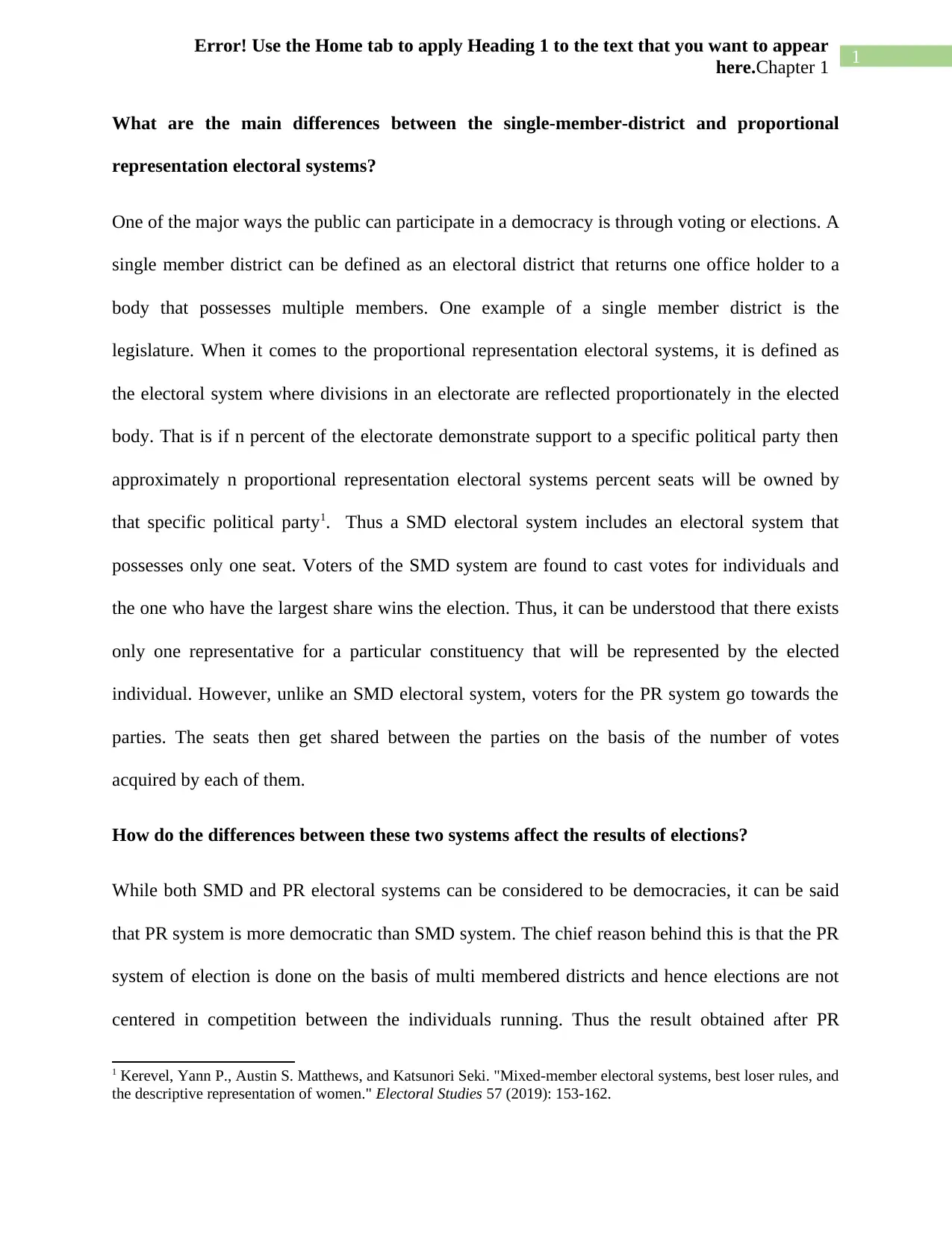
1
Error! Use the Home tab to apply Heading 1 to the text that you want to appear
here.Chapter 1
What are the main differences between the single-member-district and proportional
representation electoral systems?
One of the major ways the public can participate in a democracy is through voting or elections. A
single member district can be defined as an electoral district that returns one office holder to a
body that possesses multiple members. One example of a single member district is the
legislature. When it comes to the proportional representation electoral systems, it is defined as
the electoral system where divisions in an electorate are reflected proportionately in the elected
body. That is if n percent of the electorate demonstrate support to a specific political party then
approximately n proportional representation electoral systems percent seats will be owned by
that specific political party1. Thus a SMD electoral system includes an electoral system that
possesses only one seat. Voters of the SMD system are found to cast votes for individuals and
the one who have the largest share wins the election. Thus, it can be understood that there exists
only one representative for a particular constituency that will be represented by the elected
individual. However, unlike an SMD electoral system, voters for the PR system go towards the
parties. The seats then get shared between the parties on the basis of the number of votes
acquired by each of them.
How do the differences between these two systems affect the results of elections?
While both SMD and PR electoral systems can be considered to be democracies, it can be said
that PR system is more democratic than SMD system. The chief reason behind this is that the PR
system of election is done on the basis of multi membered districts and hence elections are not
centered in competition between the individuals running. Thus the result obtained after PR
1 Kerevel, Yann P., Austin S. Matthews, and Katsunori Seki. "Mixed-member electoral systems, best loser rules, and
the descriptive representation of women." Electoral Studies 57 (2019): 153-162.
Error! Use the Home tab to apply Heading 1 to the text that you want to appear
here.Chapter 1
What are the main differences between the single-member-district and proportional
representation electoral systems?
One of the major ways the public can participate in a democracy is through voting or elections. A
single member district can be defined as an electoral district that returns one office holder to a
body that possesses multiple members. One example of a single member district is the
legislature. When it comes to the proportional representation electoral systems, it is defined as
the electoral system where divisions in an electorate are reflected proportionately in the elected
body. That is if n percent of the electorate demonstrate support to a specific political party then
approximately n proportional representation electoral systems percent seats will be owned by
that specific political party1. Thus a SMD electoral system includes an electoral system that
possesses only one seat. Voters of the SMD system are found to cast votes for individuals and
the one who have the largest share wins the election. Thus, it can be understood that there exists
only one representative for a particular constituency that will be represented by the elected
individual. However, unlike an SMD electoral system, voters for the PR system go towards the
parties. The seats then get shared between the parties on the basis of the number of votes
acquired by each of them.
How do the differences between these two systems affect the results of elections?
While both SMD and PR electoral systems can be considered to be democracies, it can be said
that PR system is more democratic than SMD system. The chief reason behind this is that the PR
system of election is done on the basis of multi membered districts and hence elections are not
centered in competition between the individuals running. Thus the result obtained after PR
1 Kerevel, Yann P., Austin S. Matthews, and Katsunori Seki. "Mixed-member electoral systems, best loser rules, and
the descriptive representation of women." Electoral Studies 57 (2019): 153-162.
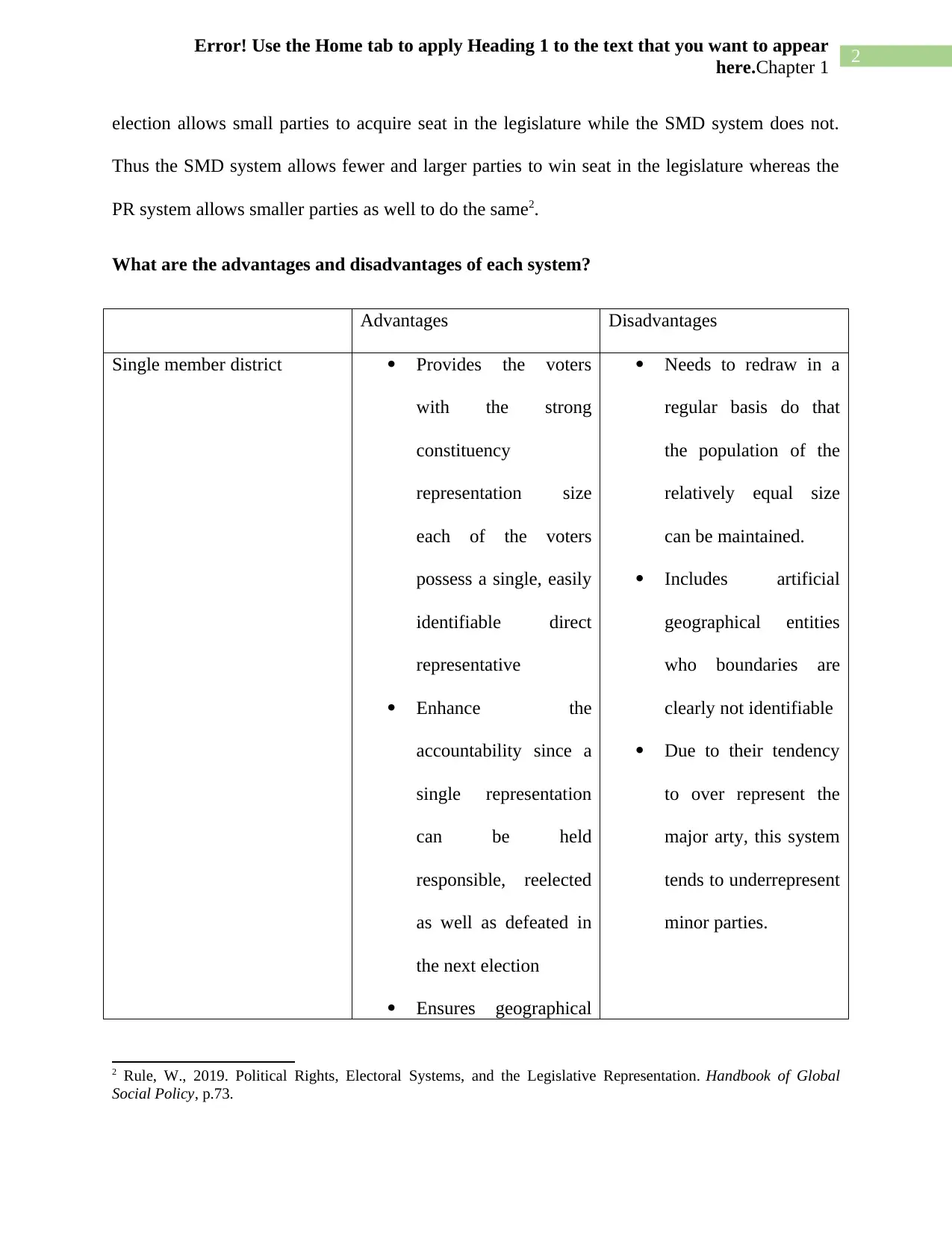
2
Error! Use the Home tab to apply Heading 1 to the text that you want to appear
here.Chapter 1
election allows small parties to acquire seat in the legislature while the SMD system does not.
Thus the SMD system allows fewer and larger parties to win seat in the legislature whereas the
PR system allows smaller parties as well to do the same2.
What are the advantages and disadvantages of each system?
Advantages Disadvantages
Single member district Provides the voters
with the strong
constituency
representation size
each of the voters
possess a single, easily
identifiable direct
representative
Enhance the
accountability since a
single representation
can be held
responsible, reelected
as well as defeated in
the next election
Ensures geographical
Needs to redraw in a
regular basis do that
the population of the
relatively equal size
can be maintained.
Includes artificial
geographical entities
who boundaries are
clearly not identifiable
Due to their tendency
to over represent the
major arty, this system
tends to underrepresent
minor parties.
2 Rule, W., 2019. Political Rights, Electoral Systems, and the Legislative Representation. Handbook of Global
Social Policy, p.73.
Error! Use the Home tab to apply Heading 1 to the text that you want to appear
here.Chapter 1
election allows small parties to acquire seat in the legislature while the SMD system does not.
Thus the SMD system allows fewer and larger parties to win seat in the legislature whereas the
PR system allows smaller parties as well to do the same2.
What are the advantages and disadvantages of each system?
Advantages Disadvantages
Single member district Provides the voters
with the strong
constituency
representation size
each of the voters
possess a single, easily
identifiable direct
representative
Enhance the
accountability since a
single representation
can be held
responsible, reelected
as well as defeated in
the next election
Ensures geographical
Needs to redraw in a
regular basis do that
the population of the
relatively equal size
can be maintained.
Includes artificial
geographical entities
who boundaries are
clearly not identifiable
Due to their tendency
to over represent the
major arty, this system
tends to underrepresent
minor parties.
2 Rule, W., 2019. Political Rights, Electoral Systems, and the Legislative Representation. Handbook of Global
Social Policy, p.73.
⊘ This is a preview!⊘
Do you want full access?
Subscribe today to unlock all pages.

Trusted by 1+ million students worldwide
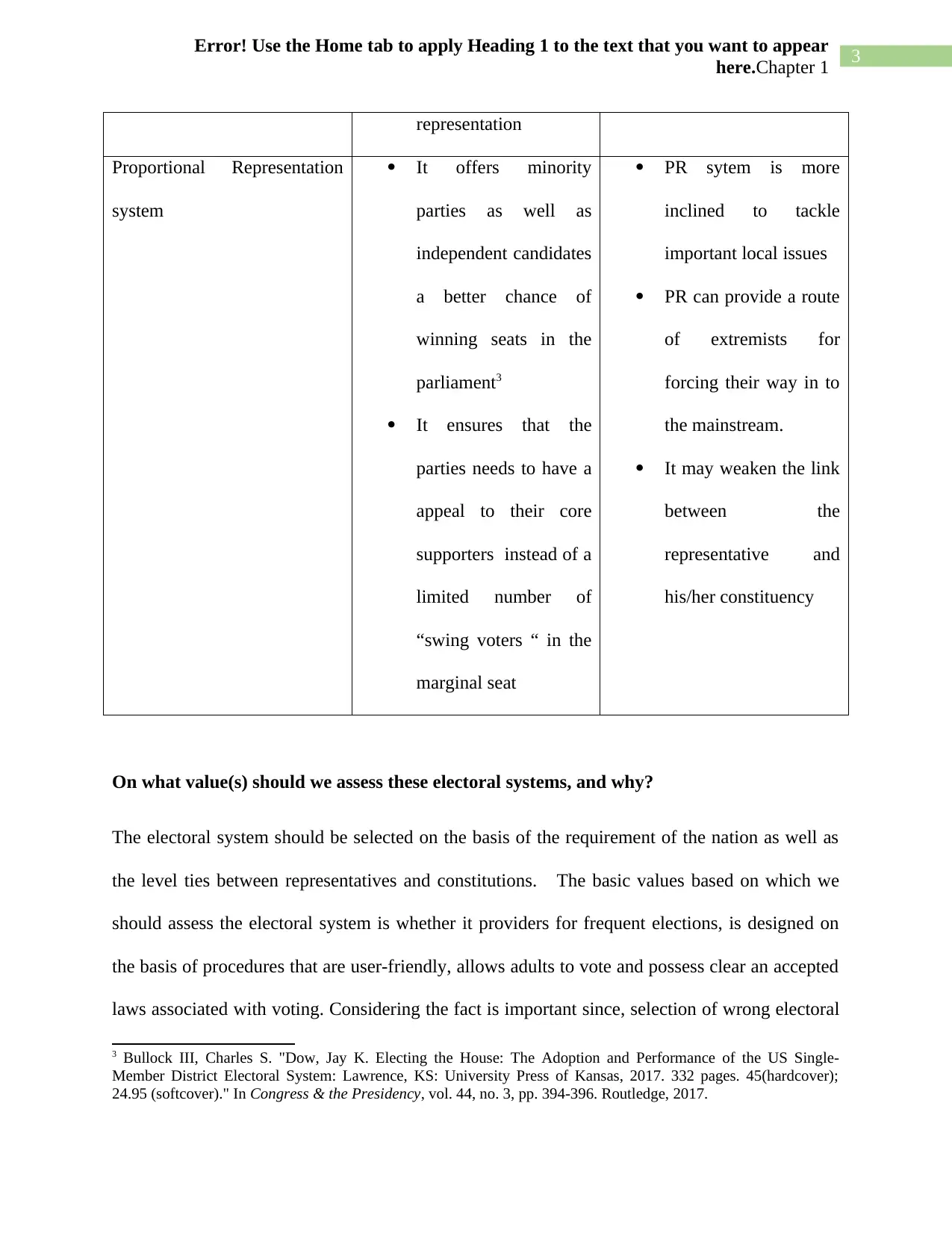
3
Error! Use the Home tab to apply Heading 1 to the text that you want to appear
here.Chapter 1
representation
Proportional Representation
system
It offers minority
parties as well as
independent candidates
a better chance of
winning seats in the
parliament3
It ensures that the
parties needs to have a
appeal to their core
supporters instead of a
limited number of
“swing voters “ in the
marginal seat
PR sytem is more
inclined to tackle
important local issues
PR can provide a route
of extremists for
forcing their way in to
the mainstream.
It may weaken the link
between the
representative and
his/her constituency
On what value(s) should we assess these electoral systems, and why?
The electoral system should be selected on the basis of the requirement of the nation as well as
the level ties between representatives and constitutions. The basic values based on which we
should assess the electoral system is whether it providers for frequent elections, is designed on
the basis of procedures that are user-friendly, allows adults to vote and possess clear an accepted
laws associated with voting. Considering the fact is important since, selection of wrong electoral
3 Bullock III, Charles S. "Dow, Jay K. Electing the House: The Adoption and Performance of the US Single-
Member District Electoral System: Lawrence, KS: University Press of Kansas, 2017. 332 pages. 45(hardcover);
24.95 (softcover)." In Congress & the Presidency, vol. 44, no. 3, pp. 394-396. Routledge, 2017.
Error! Use the Home tab to apply Heading 1 to the text that you want to appear
here.Chapter 1
representation
Proportional Representation
system
It offers minority
parties as well as
independent candidates
a better chance of
winning seats in the
parliament3
It ensures that the
parties needs to have a
appeal to their core
supporters instead of a
limited number of
“swing voters “ in the
marginal seat
PR sytem is more
inclined to tackle
important local issues
PR can provide a route
of extremists for
forcing their way in to
the mainstream.
It may weaken the link
between the
representative and
his/her constituency
On what value(s) should we assess these electoral systems, and why?
The electoral system should be selected on the basis of the requirement of the nation as well as
the level ties between representatives and constitutions. The basic values based on which we
should assess the electoral system is whether it providers for frequent elections, is designed on
the basis of procedures that are user-friendly, allows adults to vote and possess clear an accepted
laws associated with voting. Considering the fact is important since, selection of wrong electoral
3 Bullock III, Charles S. "Dow, Jay K. Electing the House: The Adoption and Performance of the US Single-
Member District Electoral System: Lawrence, KS: University Press of Kansas, 2017. 332 pages. 45(hardcover);
24.95 (softcover)." In Congress & the Presidency, vol. 44, no. 3, pp. 394-396. Routledge, 2017.
Paraphrase This Document
Need a fresh take? Get an instant paraphrase of this document with our AI Paraphraser
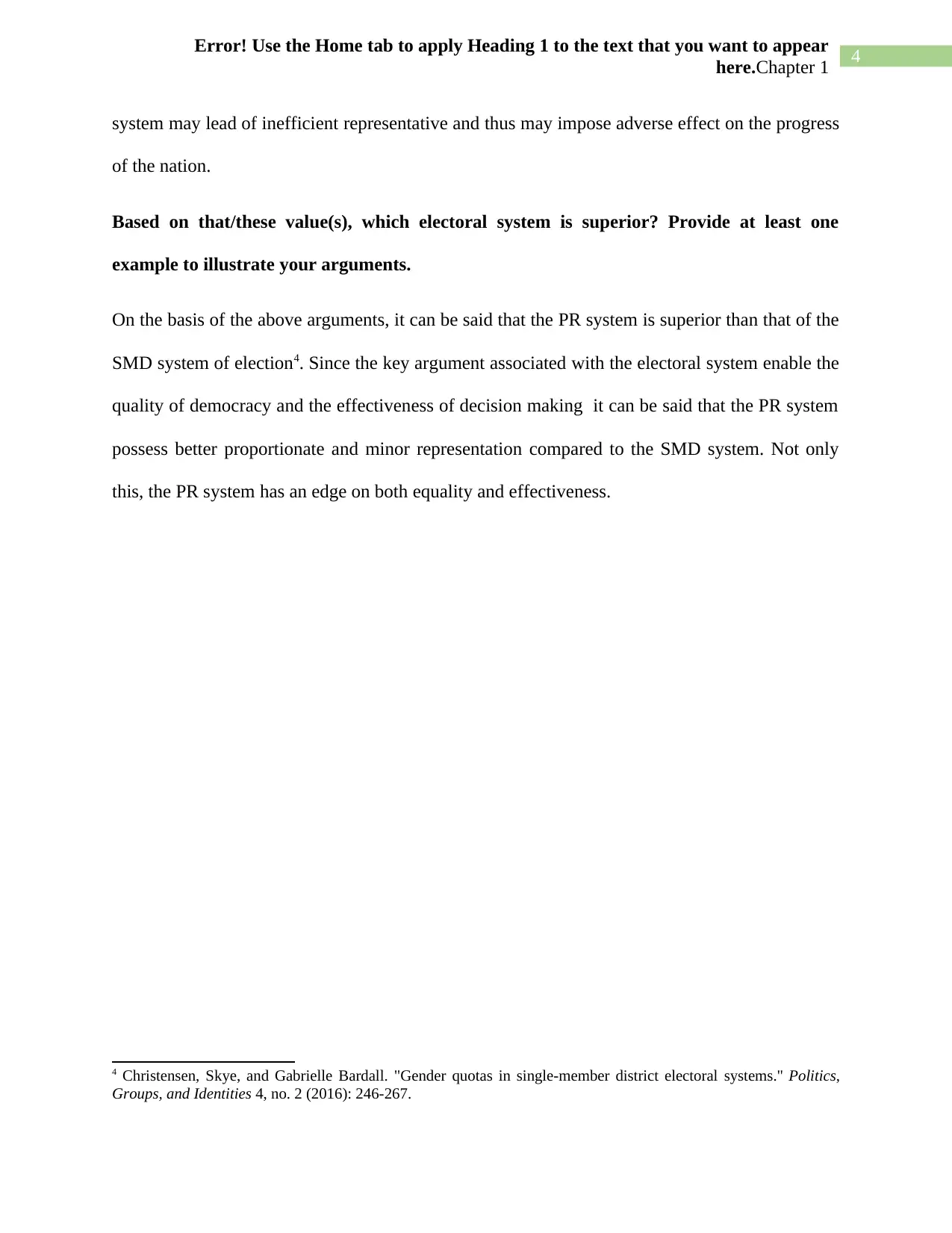
4
Error! Use the Home tab to apply Heading 1 to the text that you want to appear
here.Chapter 1
system may lead of inefficient representative and thus may impose adverse effect on the progress
of the nation.
Based on that/these value(s), which electoral system is superior? Provide at least one
example to illustrate your arguments.
On the basis of the above arguments, it can be said that the PR system is superior than that of the
SMD system of election4. Since the key argument associated with the electoral system enable the
quality of democracy and the effectiveness of decision making it can be said that the PR system
possess better proportionate and minor representation compared to the SMD system. Not only
this, the PR system has an edge on both equality and effectiveness.
4 Christensen, Skye, and Gabrielle Bardall. "Gender quotas in single-member district electoral systems." Politics,
Groups, and Identities 4, no. 2 (2016): 246-267.
Error! Use the Home tab to apply Heading 1 to the text that you want to appear
here.Chapter 1
system may lead of inefficient representative and thus may impose adverse effect on the progress
of the nation.
Based on that/these value(s), which electoral system is superior? Provide at least one
example to illustrate your arguments.
On the basis of the above arguments, it can be said that the PR system is superior than that of the
SMD system of election4. Since the key argument associated with the electoral system enable the
quality of democracy and the effectiveness of decision making it can be said that the PR system
possess better proportionate and minor representation compared to the SMD system. Not only
this, the PR system has an edge on both equality and effectiveness.
4 Christensen, Skye, and Gabrielle Bardall. "Gender quotas in single-member district electoral systems." Politics,
Groups, and Identities 4, no. 2 (2016): 246-267.
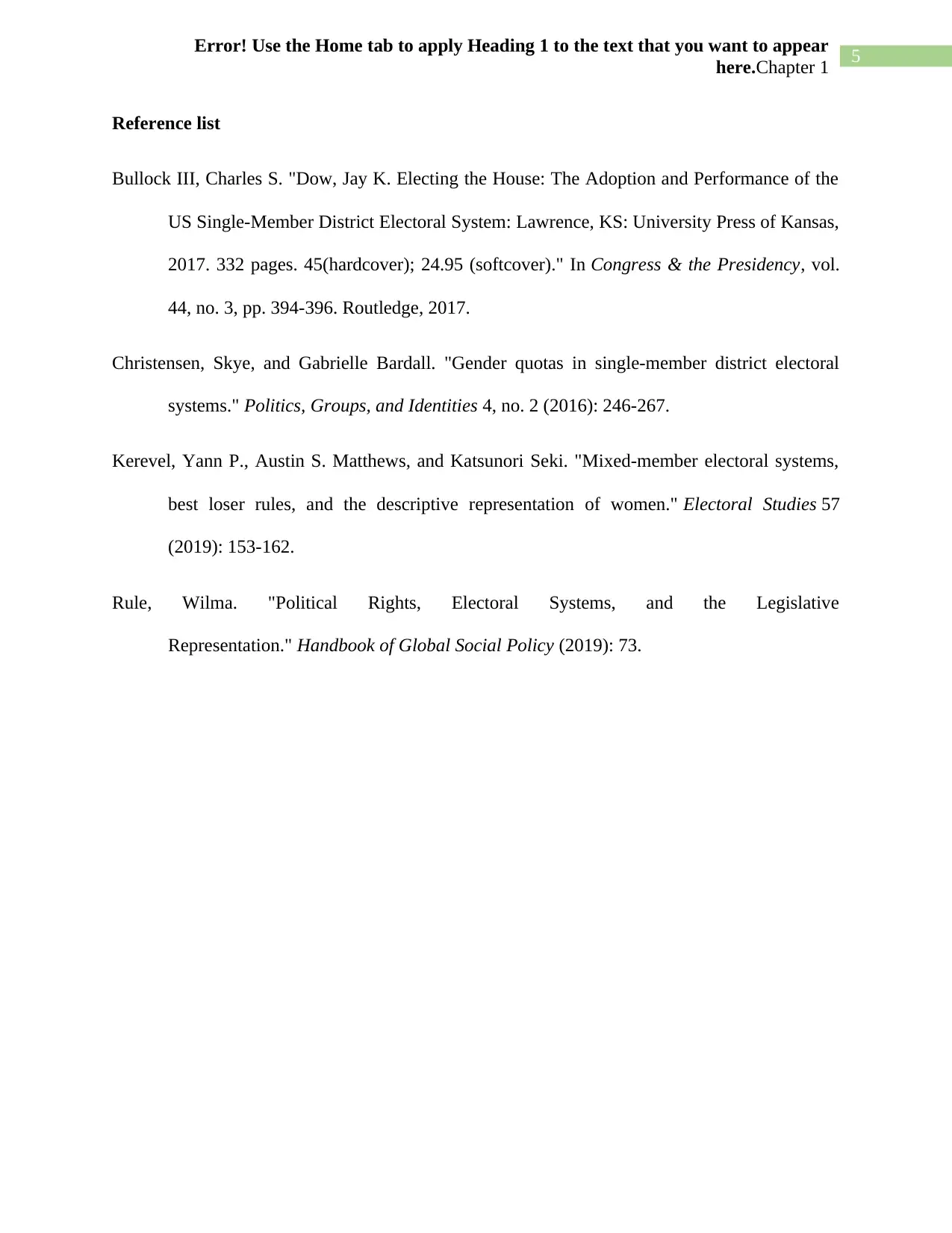
5
Error! Use the Home tab to apply Heading 1 to the text that you want to appear
here.Chapter 1
Reference list
Bullock III, Charles S. "Dow, Jay K. Electing the House: The Adoption and Performance of the
US Single-Member District Electoral System: Lawrence, KS: University Press of Kansas,
2017. 332 pages. 45(hardcover); 24.95 (softcover)." In Congress & the Presidency, vol.
44, no. 3, pp. 394-396. Routledge, 2017.
Christensen, Skye, and Gabrielle Bardall. "Gender quotas in single-member district electoral
systems." Politics, Groups, and Identities 4, no. 2 (2016): 246-267.
Kerevel, Yann P., Austin S. Matthews, and Katsunori Seki. "Mixed-member electoral systems,
best loser rules, and the descriptive representation of women." Electoral Studies 57
(2019): 153-162.
Rule, Wilma. "Political Rights, Electoral Systems, and the Legislative
Representation." Handbook of Global Social Policy (2019): 73.
Error! Use the Home tab to apply Heading 1 to the text that you want to appear
here.Chapter 1
Reference list
Bullock III, Charles S. "Dow, Jay K. Electing the House: The Adoption and Performance of the
US Single-Member District Electoral System: Lawrence, KS: University Press of Kansas,
2017. 332 pages. 45(hardcover); 24.95 (softcover)." In Congress & the Presidency, vol.
44, no. 3, pp. 394-396. Routledge, 2017.
Christensen, Skye, and Gabrielle Bardall. "Gender quotas in single-member district electoral
systems." Politics, Groups, and Identities 4, no. 2 (2016): 246-267.
Kerevel, Yann P., Austin S. Matthews, and Katsunori Seki. "Mixed-member electoral systems,
best loser rules, and the descriptive representation of women." Electoral Studies 57
(2019): 153-162.
Rule, Wilma. "Political Rights, Electoral Systems, and the Legislative
Representation." Handbook of Global Social Policy (2019): 73.
⊘ This is a preview!⊘
Do you want full access?
Subscribe today to unlock all pages.

Trusted by 1+ million students worldwide
1 out of 6
Related Documents
Your All-in-One AI-Powered Toolkit for Academic Success.
+13062052269
info@desklib.com
Available 24*7 on WhatsApp / Email
![[object Object]](/_next/static/media/star-bottom.7253800d.svg)
Unlock your academic potential
Copyright © 2020–2025 A2Z Services. All Rights Reserved. Developed and managed by ZUCOL.




